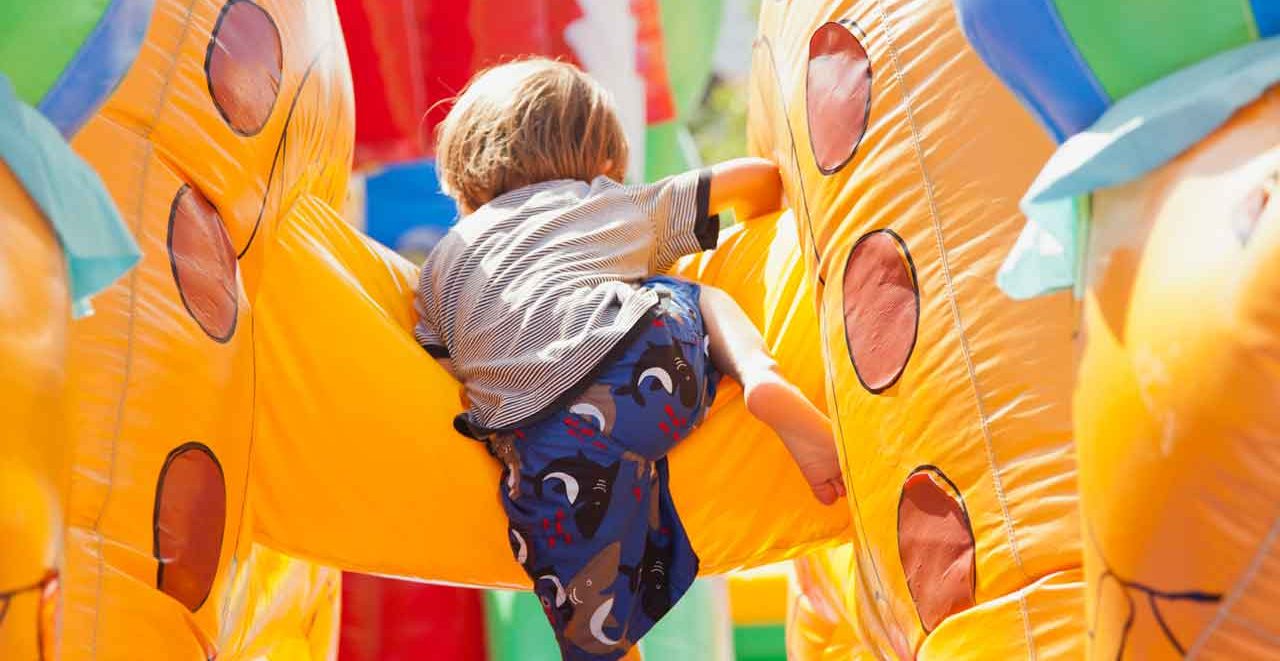The Dangers of Bounce Houses

Moonwalks and similar inflated bounce houses are loads of fun for kids — but are bounce house safe? Here’s what every parent should know.
If you have kids, the odds are you know what a bounce house is. Also called moonwalks and inflatable amusements, bounce houses are often rented for birthday parties and frequently found at carnivals, neighborhood festivals, and other events. These large, inflated play structures are typically designed to look like a storybook house, castle, or a giant toy, but their main appeal is floors that bounce.
Of course, a trampoline-like floor is difficult to walk on but perfect for little ones to jump, hop, and flop on while laughing with delight. Some inflatable play structures have narrow tunnels and slides, too. This all sounds like loads of fun for children and it usually is — until it’s not.
YOU MIGHT ALSO LIKE: Laundry Detergent Packets Put Children in Danger
Are bounce houses safe?
News reports have covered a few rare but horrific examples of bounce houses outdoors swept into the air or turned over by strong winds. In 2014, one rose 300 feet in the air, injuring several people. A gust of wind lifted up another bounce house the same year, causing the structure to tumble across a park. Two children trapped inside had to be hospitalized.
Four-year-old Deacon Rambaud was playing near a bounce house when he was pulled under it and trapped in the structure’s matting. Thankfully, his father saw what happened and rushed to rescue his son before the boy suffocated.
While these types of incidents are few and far between, more common kinds of bounce house accidents happen in the U.S. every year. And the number of injuries has increased over the past decade, most likely because there are more bounce houses.
Nathalia Martin, age 11, and her mom never dreamed the young girl would be injured at her mother’s company picnic last year when the youngster climbed to the top of a slide inside a bounce house. But as other children kept sliding around her, Nathalia was trapped. Her lower leg, caught in bunched-up material, snapped. After three surgeries so far, Nathalia is still recovering from her injuries.
Research by the Consumer Product Safety Commission found that, between 2003 and 2013, over 113,000 children ended up in emergency departments due to injuries associated with moonwalks and similar inflatable play structures. Sixty-one percent of injuries in the years 2011 to 2013 occurred in kids between the ages of 4 and 15 years of age. Although rare, some of the bounce house accidents were deadly — 12 children died between 2003 and 2013 from their injuries, according to Consumer Product Safety Commission.
A study found over 60 percent of bounce house injuries involved fractures, muscle strains, and sprains. Boys were slightly more likely to be hurt in the play structures than girls.
University of Georgia (UGA) researchers have found another, previously unrecognized danger inside inflatable play structure — soaring temperatures.
"I knew it was a problem when I watched my child in one on a particularly hot day and our early findings confirmed my suspicions," said researcher Marshall Shepherd, PhD, UGA professor of geography and atmospheric sciences. “Hopefully it makes parents more aware of something they probably overlooked.”
The research team conducted experiments with a bounce house on the UGA campus with weather conditions representative of a typical summer day. Five hours of measurements found temperatures inside the play structure were consistently higher than outside — climbing between four and seven degrees to reach a temperature of over 100 F.
Overheating
Bottom line: Bounce houses create an environment that locks heat inside them, not unlike cars parked with windows rolled up.
"Heat illnesses like heat stroke can be deadly and occur in children participating in sports, left alone in parked cars, and as our study shows, potentially when playing in bounce houses," said Andrew Grundstein, PhD, UGA professor of geography and co-author of the study. "Signs there is a problem may include fatigue, nausea, vomiting, dizziness, and flushed, moist skin."
Some children are especially susceptible to over-heating, according to the American Academy of Pediatrics. For example, youngsters who have recently had gastrointestinal distress (vomiting, diarrhea) or fever may be dehydrated to begin with, and chronic conditions such as diabetes, obesit, and hyperthyroidism also increase the risk of heat exhaustion and stroke.
The potential danger of bounce houses doesn’t mean kids can never play in them — but parents should make sure an adult trained in bounce houses safety is present and, if several kids are in the bounce structure at a time, all should be about the same age and weight, according to the Child Injury Prevention Alliance (CIPA).
Visit the CIPA website for more bounce house safety information and injury prevention tips.
Updated:
February 27, 2020
Reviewed By:
Janet O’Dell, RN